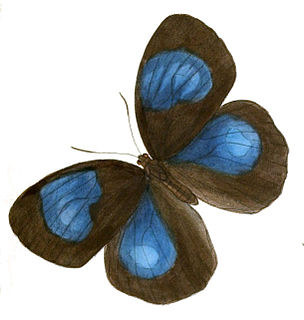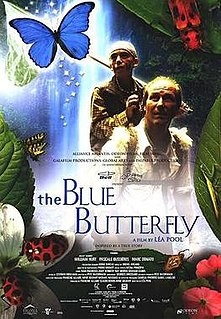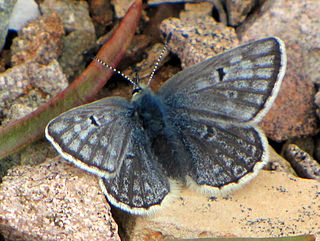| Thaumantis | |
|---|---|
 | |
| T. klugius lucipor dark blue jungle glory Sabah, Borneo, Malaysia | |
| Scientific classification | |
| Kingdom: | Animalia |
| Phylum: | Arthropoda |
| Class: | Insecta |
| Order: | Lepidoptera |
| Family: | Nymphalidae |
| Subfamily: | Satyrinae |
| Genus: | Thaumantis Hübner, [1826] [1] |
| Synonyms | |
| |
Thaumantis is a genus of butterflies in the family Nymphalidae. Thaumantis is a Southeast Asian genus of large, showy butterflies. The dorsal surfaces of their wings have iridescent purplish blue bands.

The Nymphalidae are the largest family of butterflies with more than 6,000 species distributed throughout most of the world, belonging to the superfamily Papilionoidea. These are usually medium-sized to large butterflies. Most species have a reduced pair of forelegs and many hold their colourful wings flat when resting. They are also called brush-footed butterflies or four-footed butterflies, because they are known to stand on only four legs while the other two are curled up; in some species, these forelegs have a brush-like set of hairs, which gives this family its other common name. Many species are brightly coloured and include popular species such as the emperors, monarch butterfly, admirals, tortoiseshells, and fritillaries. However, the under wings are, in contrast, often dull and in some species look remarkably like dead leaves, or are much paler, producing a cryptic effect that helps the butterflies blend into their surroundings.

Southeast Asia or Southeastern Asia is a subregion of Asia, consisting of the countries that are geographically south of Japan, Korea and China, east of India, west of Papua New Guinea, and north of Australia. Southeast Asia is bordered to the north by East Asia, to the west by South Asia and the Bay of Bengal, to the east by Oceania and the Pacific Ocean, and to the south by Australia and the Indian Ocean. The region is the only part of Asia that lies partly within the Southern Hemisphere, although the majority of it is in the Northern Hemisphere. In contemporary definition, Southeast Asia consists of two geographic regions:
- Mainland Southeast Asia, also known historically as Indochina, comprising parts of Eastern India, Vietnam, Laos, Cambodia, Thailand, Myanmar, and West Malaysia.
- Maritime Southeast Asia, also known historically as Nusantara, the East Indies and Malay Archipelago, comprises the Andaman and Nicobar Islands of India, Indonesia, East Malaysia, Singapore, Philippines, East Timor, Brunei, Christmas Island, and the Cocos (Keeling) Islands. Taiwan is also included in this grouping by many anthropologists.
















